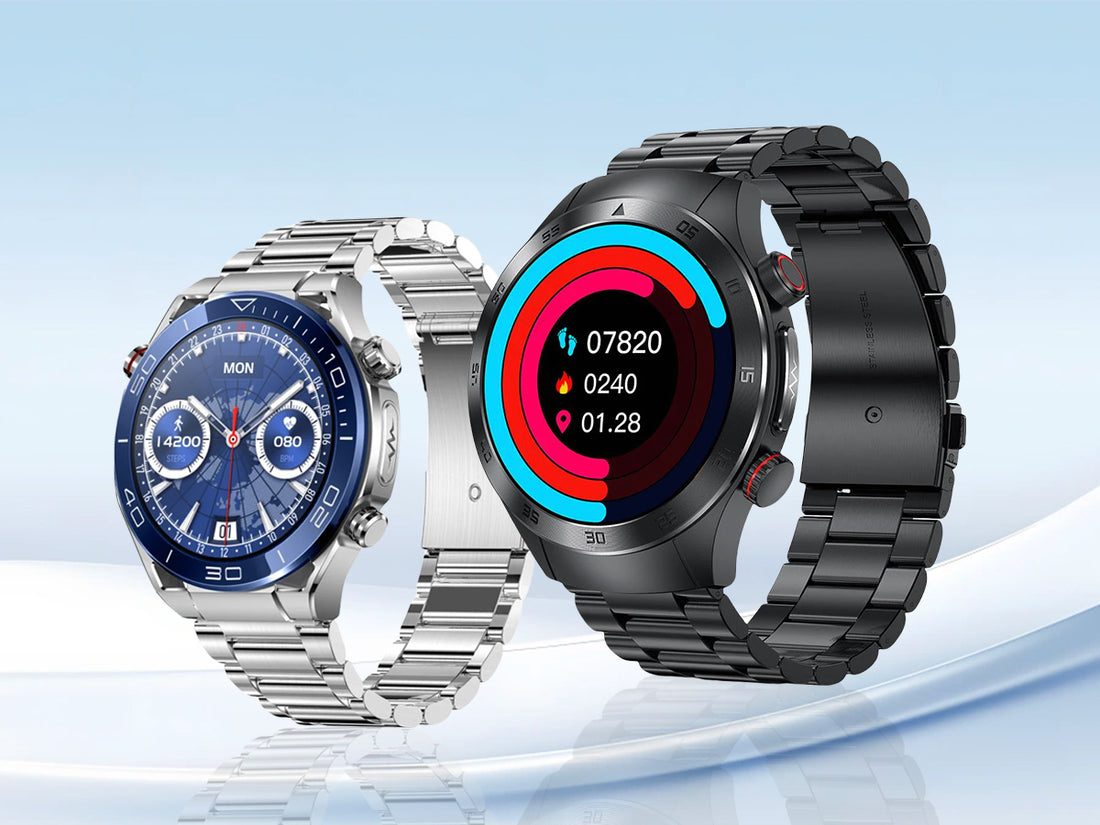Introduction: Overview of FITAOS Max 1 and FITAOS Max 2
FITAOS Max 1 and FITAOS Max 2 offer innovative health-tracking features, catering to users who want deeper insights into their well-being. While FITAOS Max 1 excels in essential health metrics like heart rate, blood pressure, and blood glucose monitoring, FITAOS Max 2 introduces advanced functionalities such as laser therapy, uric acid monitoring, and blood lipid monitoring. These additions make the Max 2 a powerful option for proactive health management.
Feature Comparison Table
|
Feature |
FITAOS Max 1 |
FITAOS Max 2 |
|
Heart Rate Monitoring |
✔ |
✔ |
|
Blood Pressure Monitoring |
✔ |
✔ |
|
Blood Glucose Monitoring |
✔ |
✔ |
|
Laser Therapy |
❌ |
✔ |
|
Uric Acid Monitoring |
❌ |
✔ |
|
Blood Lipid Monitoring |
❌ |
✔ |
|
Bluetooth Talk |
✔ |
✔ |
|
Battery Life |
Up to 5 days |
Up to 7 days |
1. Laser Therapy: FITAOS Max 2’s Advanced Health Innovation
Overview of Laser Therapy in Smartwatches
Laser therapy is an advanced feature rarely found in the smartwatch market. It works by delivering light waves to improve blood circulation and help reduce inflammation, which can aid in managing conditions like joint pain. While high-end models like Apple Watch Series 9 and Fitbit Sense 2 focus on health metrics, neither offers therapeutic options like laser therapy.
Benefits of FITAOS Max 2’s Laser Therapy
The FITAOS Max 2 leverages laser therapy to promote wellness by helping users improve circulation. This can be especially beneficial for those dealing with joint issues, muscle recovery, or general pain management, offering advantages beyond what’s available with standard smartwatches.
Comparison with FITAOS Max 1
Since FITAOS Max 1 doesn’t include laser therapy, users seeking this specific health benefit may find the Max 2 a more suitable choice. FITAOS Max 2’s laser therapy not only broadens its health monitoring capabilities but also enhances its ability to support proactive wellness.

2. Uric Acid Monitoring: Revolutionizing Health Tracking with FITAOS Max
Importance of Uric Acid Monitoring
Tracking uric acid is crucial for individuals managing conditions such as gout and metabolic health, providing early warning signs that can lead to better management. While Apple Watch and Fitbit excel in tracking general fitness and heart health, they lack this specific function for uric acid, making the FITAOS Max 2 particularly valuable for those with uric acid concerns.
How FITAOS Max 2 Excels in Uric Acid Monitoring
The FITAOS Max 2 introduces a groundbreaking uric acid monitoring feature, offering users insights into their metabolic health over time. By tracking these levels, users can maintain awareness of any trends that could signal changes in their diet or lifestyle needs.
Comparison with FITAOS Max 1
While FITAOS Max 1 includes core health metrics, it does not offer uric acid tracking. This capability on the Max 2 is a key differentiator for users needing targeted health insights that other mainstream smartwatches do not provide.

3. Blood Lipid Monitoring: Advanced Health Data on FITAOS Max 2
Role of Blood Lipid Monitoring in Heart Health
Blood lipid monitoring can offer valuable information about heart health, helping users detect risks early. High blood lipids are often linked with heart disease, so keeping an eye on these levels is essential for overall cardiovascular wellness.
Advantages of Blood Lipid Monitoring on FITAOS Max 2
With blood lipid monitoring, the FITAOS Max 2 provides a more holistic view of a user's cardiovascular risk factors. This added functionality offers early indicators, allowing users to take preventive steps in their heart health journey—making it ideal for those committed to heart health management.
Comparison with FITAOS Max 1
While both models monitor heart rate and blood pressure, the addition of blood lipid monitoring on FITAOS Max 2 offers more comprehensive cardiovascular tracking. Users seeking a full spectrum of heart health insights may find FITAOS Max 2 a more powerful health management tool.

4. Core Features Comparison: Heart Rate, Blood Pressure, and Glucose Monitoring
Core Health Tracking on Both Models
Both FITAOS Max 1 and FITAOS Max 2 provide essential health tracking capabilities, including heart rate, blood pressure, and blood glucose monitoring, making them reliable for everyday health awareness. These features align with popular health metrics found on Fitbit and Apple Watch, ensuring both models meet basic health monitoring needs.
Additional Sensors on FITAOS Max 2
Beyond these core metrics, FITAOS Max 2 includes additional sensors for laser therapy, uric acid, and blood lipid monitoring, making it a standout option in the market. This range is well-suited for users who require more detailed health data than typical mainstream options.
Practical Applications
For users who prioritize basic health tracking, FITAOS Max 1 is an effective, budget-friendly choice. However, those seeking a more holistic health approach, especially with a focus on blood lipid and uric acid monitoring, may benefit from the FITAOS Max 2’s extended features.
5. User Experience: Battery Life, Interface, and App Compatibility
Battery Life
Battery life is essential in any smartwatch. FITAOS Max 1 lasts up to 5 days, while FITAOS Max 2 extends this to 7 days, offering a practical edge for users who need extended tracking without frequent recharging. In comparison, Apple Watch often requires daily charging, giving FITAOS Max 2 an advantage in convenience.
User Interface and Ease of Use
Both FITAOS models offer clear, intuitive interfaces, designed for ease of use. The display on FITAOS Max 2, however, is optimized for a smoother navigation experience, making it easier to access its diverse health features.
App Integration
Both models integrate with popular health apps, but FITAOS Max 2’s broader sensor compatibility enhances data analysis options for users tracking multiple health metrics. This provides a more thorough health profile than many traditional fitness apps available on Apple Watch or Fitbit.

